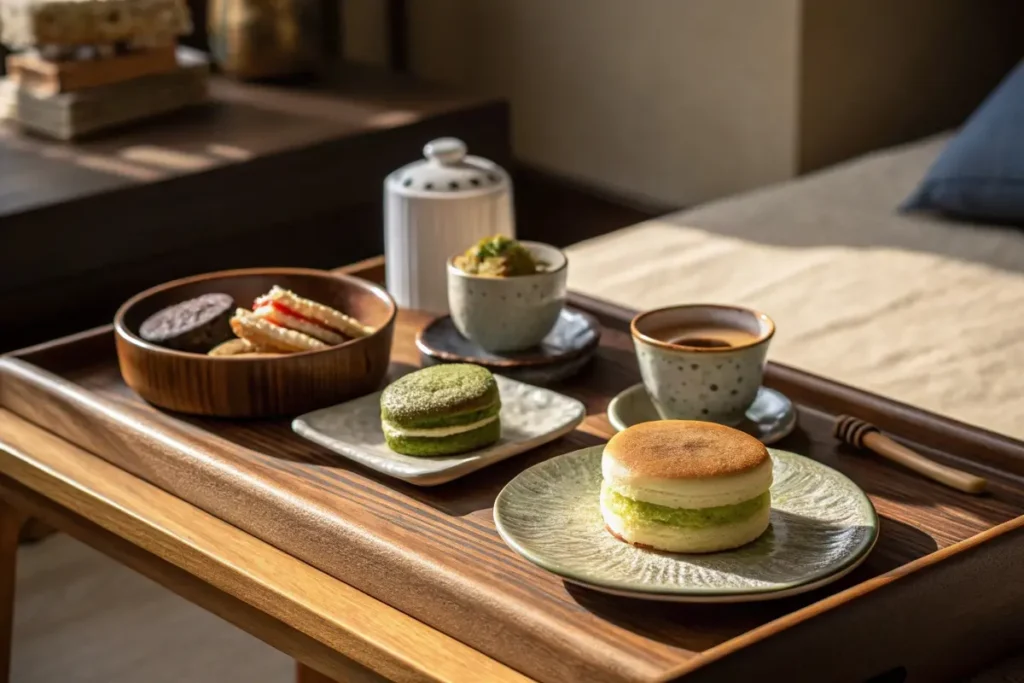What is a popular Japanese dessert? From delicate mochi creations to airy soufflé pancakes, Japan’s confectionery scene captivates dessert lovers across the globe. Whether you’re drawn to wagashi (traditional sweets) or Western-inspired pastries with a Japanese twist, there’s no shortage of japanese dessert ideas worth exploring. This comprehensive guide will survey what is the most popular pastry in Japan, what is the national sweet of Japan, and what is a popular dessert in Tokyo. Along the way, we’ll uncover the cultural roots, ingredient highlights, and practical recipes that make these treats both comforting and innovative.
D’accord ! Voici le texte modifié en gardant “Japanese Dessert Recipes” tel quel et en intégrant “Japanese Dessert Ideas” :
If you’re craving more guidance on how to make your own Japanese-inspired desserts, you can delve into our Japanese Dessert Recipes. There you’ll find detailed instructions spanning both classic mochi-based sweets and modern layered cakes. For even more inspiration, check out these Japanese Dessert Ideas – perfect for any occasion, from a family gathering to an elegant dinner party.
Introduction
Japanese desserts combine a remarkable variety of flavors, textures, and presentations. Mochi might be the go-to for many, but there’s an entire realm of treats—like dorayaki, taiyaki, custard puddings, and sweet potato pies—that illustrate Japan’s dynamic sweet tooth. If you’ve ever wondered what is the most popular pastry in Japan, you’d likely find answers in melt-in-your-mouth cheesecakes, pillowy soufflé pancakes, or the ubiquitous cream-filled choux pastries found in convenience stores. For more inspiration, explore our Japanese Dessert Ideas to dive deeper into these deliciously diverse sweets.
However, japanese dessert ideas go beyond mainstream hits. Traditional sweets (wagashi) still reign in tea ceremonies, festivals, and everyday snack culture, while upscale patisseries in Tokyo push the boundaries by fusing local ingredients—matcha, yuzu, or azuki beans—with Western pastry techniques. These evolutions encourage both novices and seasoned cooks to try new combinations and flours in their own kitchens.
Craving a deep dive into this dessert tapestry? You’re in the right place. From what is the national sweet of Japan (spoiler: it’s arguably wagashi, though many might point to mochi) to the popular dessert in Tokyo fads (like taiyaki ice cream), this article will illuminate the bright palette of Japanese dessert culture. Ready to discover easy recipes, cultural insights, and practical tips? For even more inspiration, explore our Japanese Dessert Ideas—grab your whisk, let’s begin!
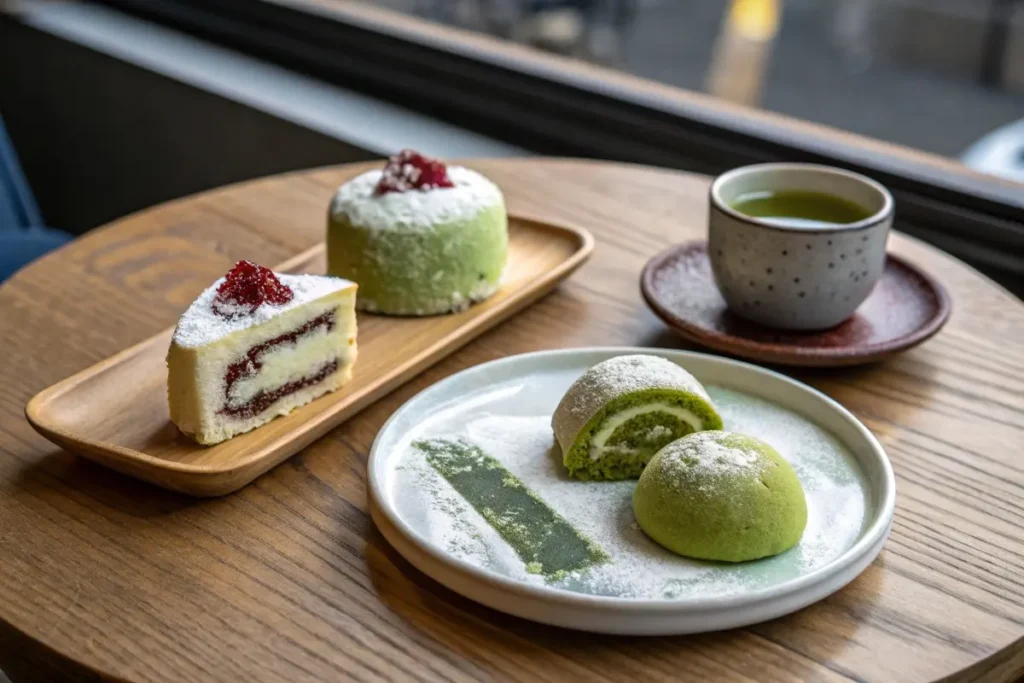
The Variety of Japanese Desserts
1. Wagashi: The Core of Traditional Sweets
Wagashi, often referred to as the national sweet of Japan, forms the bedrock of Japanese dessert culture. These delicate treats typically rely on plant-based ingredients like sweet bean paste (anko), glutinous rice flour (mochiko), and agar (kanten). Common wagashi types include:
- Daifuku: Soft mochi stuffed with sweet bean paste, sometimes infused with fresh fruit like strawberry (ichigo daifuku).
- Dorayaki: Pancake sandwich filled with anko, famously loved by the anime character Doraemon.
- Yokan: A gelatinous, subtly sweet block made from adzuki beans and agar, commonly served in slices.
Wagashi usually pairs with tea, complementing the drink’s bitter or earthy notes with mild sweetness. To delve deeper into wagashi fundamentals, check our Traditional Japanese Desserts Recipe for step-by-step guidance on classic sweet bean concoctions.
2. Western-Inspired Sweets (Yōgashi)
After the Meiji Restoration (late 19th century): Western confections arrived in Japan. Pastry shops sprang up, eventually developing their unique spins on staples like cheesecake, chiffon cakes, and cream puffs. Over the years, local bakers integrated matcha, sweet potato, and kinako (toasted soybean flour) into pastries, forging that signature East-meets-West taste.
- Soufflé Pancakes: One of the most popular pastry items in Japan, these fluffy pancakes soared in popularity for their jiggly texture and Instagram-worthy appearance.
- Matcha-Filled Roll Cakes: A soft sponge rolled with whipped cream laced with matcha or azuki paste.
- Mont Blanc Cakes: Originally a chestnut dessert from Europe, now frequently done with sweet potato or green tea paste in Japan.
3. Street-Food Desserts
On the bustling streets or at festivals, you’ll find taiyaki (fish-shaped waffles stuffed with anko or custard), dango (grilled rice dumplings on skewers, often dipped in sweet soy sauce glaze), and seasonal sweets like roasted sweet potatoes in winter. In big cities like Tokyo or Osaka, creative variations abound: taiyaki ice cream cones, mochi doughnuts, and more.
4. Regional Specialties
Each prefecture in Japan cherishes its local produce, fueling specialized desserts. For instance, in Okinawa, the abundant sugar cane usage influences items like sata andagi (Okinawan doughnuts). Meanwhile, Hokkaido’s dairy results in famously rich cheesecakes and soft-serve ice creams.
For a savory sweet potato twist, our Mashed Japanese Sweet Potato Recipe can double as a dessert base—top it with a drizzle of honey or a sprinkle of cinnamon. This adaptability illustrates how a single staple ingredient morphs into an indulgent treat.
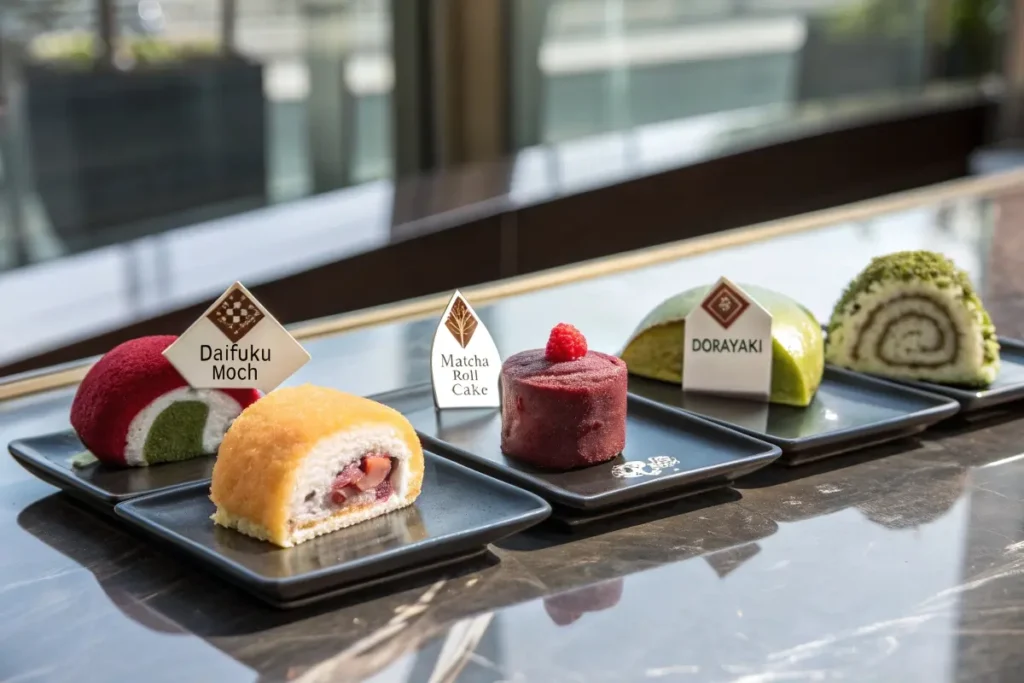
Key Ingredients and Techniques
1. Sweet Bean Paste (Anko)
Central to many japanese dessert ideas, anko is produced by boiling adzuki beans with sugar, then mashing or blending them. Smooth anko (koshi-an) is sieved to a fine consistency, while chunky anko (tsubu-an) retains some bean bits. This paste fills mochi, dorayaki, steamed buns, and more. Anko’s nuanced sweetness and slight earthy note anchor these treats.
2. Mochi and Rice Flours
Japan’s reliance on rice reflects in various desserts:
- Glutinous Rice Flour (Shiratama-ko): Used for mochi dumplings, yielding a chewy, springy texture.
- Regular Rice Flour (Joshinko): For certain baked goods or wagashi needing a firmer bite.
- Mochi-Making Process: Pounding steamed glutinous rice into a malleable dough is a centuries-old tradition. Modern shortcuts use microwaves or machines, but the core principle remains: transform sticky rice into a uniform, pliant mass.
3. Matcha and Other Flavors
Matcha stands out for its grassy, slightly bitter taste, pairing seamlessly with sweeteners. It’s not only used in tea but also in:
- Cake Batters: A swirl of matcha adds color and flavor.
- Cream Fillings: Combining whipped cream with matcha powder results in a vibrant green hue.
- Gelato or Soft Serve: Popular in cafes, bridging classic tea traditions with modern dessert mania.
Beyond matcha, Japanese desserts also incorporate chestnut purée (kuri), yuzu (a citrus fruit with a tangy aroma), and purple sweet potatoes for vibrant hues. Each flavor harmonizes with the moderate sweetness typical of local confections.
4. Artisan Skills vs. Home Cooking
Many elaborate wagashi or patisserie items can be purchased at specialty shops. But simpler confections—like dango or mitsumame (a fruit-and-agar dessert)—are feasible at home. Mastering mochi, for instance, typically demands precision. Still, the rising availability of glutinous rice flour and anko in global grocery markets (or online) simplifies do-it-yourself adventures.
5. Balancing Aesthetics and Taste
A hallmark of Japanese sweets is the visual appeal: molded shapes, pastel or earthy colors, and garnishes echoing seasonal motifs. The dessert’s design complements the taste, ensuring it’s pleasing both to the palate and the eye. This synergy resonates in ceremonial contexts (like a tea ceremony), festive gatherings, or even everyday snacking. Even a quick, store-bought pastry might exhibit an exquisite presentation.
To integrate these concepts in your kitchen, you might begin with a step-by-step mochi tutorial or try out a straightforward anko-based pastry. For a robust compilation of simpler dessert recipes, see our Japanese Dessert Recipes—a resource bridging tradition and modern tastes, from delicate wagashi to decadent matcha cakes.
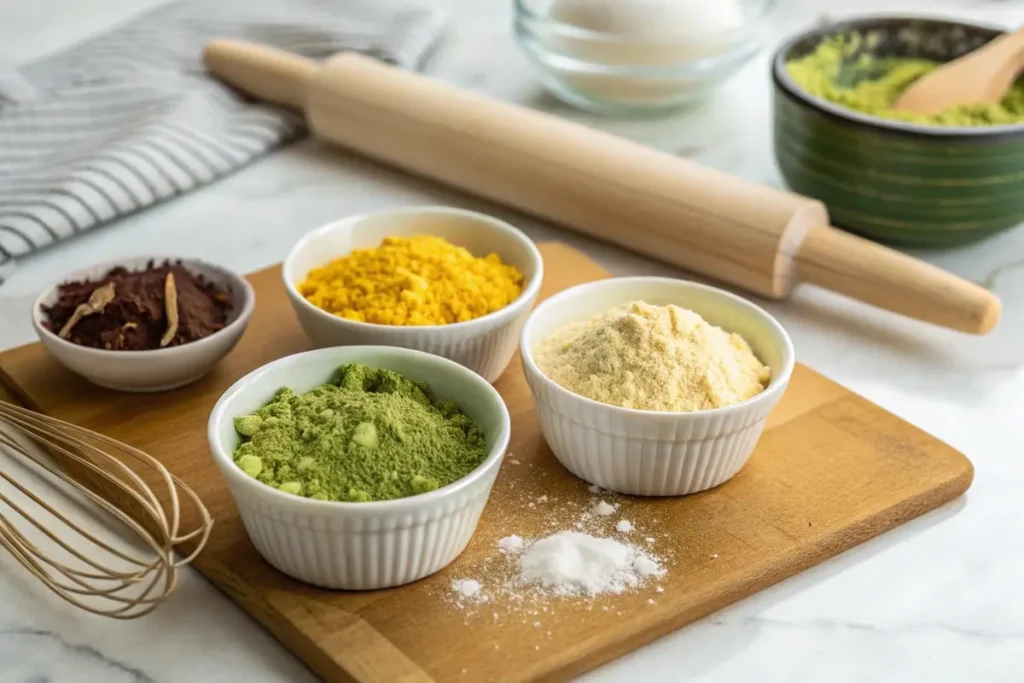
History and Examples of Japanese Dessert Ideas
1. Edo Period: Urban Confectionery Growth
During the Edo period (1603–1868), Japan’s population boomed, and so did sweet shops. Sugar, once rare, became more accessible via trade, spurring the evolution of confections like castella (Portuguese-inspired sponge cake) and refined mochi-based treats. Edo townspeople sought small, portable sweets, leading to the popularity of dorayaki and senbei. Though these were simpler by today’s standards, they laid the groundwork for modern patisseries and wagashi artistry.
2. Meiji Western Influence
Post-1868, Japan rapidly modernized and Western pastries—custards, cream puffs, layered cakes—arrived. Local chefs began merging these techniques with Japanese flavors: matcha macarons, sake-laced tiramisu, and more. An influx of French or Italian pastry knowledge further pushed dessert boundaries. The outcome? A dual identity in Japanese sweets: wagashi for tradition, yōgashi (Western sweets) for novelty, bridging them with creative flair.
3. Innovations in the 20th Century
Factories mechanized mochi production, rolled cakes, and cheesecake, broadening their availability in conbini (convenience stores). Meanwhile, high-end patisseries in Tokyo or Kyoto refined premium lines, sometimes featuring gold leaf or intricate sculpting. The 20th century also saw local dessert entrepreneurs adopt new textures. For example, the airy soufflé cheesecake gained global fandom as a “Japanese style,” reflecting the country’s knack for reinterpreting foreign desserts with a softer twist.
4. Cultural Significance
Desserts in Japan extend beyond mere indulgence:
- Seasonal Ties: Observed in cherry blossom confections during spring or sweet potato tarts in autumn.
- Ceremonial Roles: Tea ceremonies, festivals (matsuri), and family milestones each have sweets intricately linked to custom—like red bean desserts signifying good fortune.
- Gift Culture: Carefully boxed pastries or wagashi sets frequently serve as souvenirs or greeting gifts. The refined packaging echoes Japanese emphasis on courtesy.
5. Contemporary Dessert Boom
In major cities, dessert cafes flourish—offering artisanal parfaits, mochi-infused bubble teas, and flamboyant matcha sweets. Meanwhile, home cooks experiment with do-it-yourself kits, occasionally gleaning from blog tutorials or cooking shows. Some prefer replicating the staple big sellers, like the Japanese fluffy cheesecake, popular globally for its soufflé-like consistency.
If you’re feeling inspired, a good starting point might be our Easy Japanese Tuna Salad Recipe. Although it’s savory, that site also references dessert tips and highlights how easy it can be to pivot from light main courses to sweet finales—seamlessly merging tradition with day-to-day practicality.
Practical Examples/Use Cases
1. Hosting a Japanese Dessert Night
- Scenario: You want to impress guests with japanese dessert ideas beyond mochi.
- Approach: Serve up mini matcha cheesecakes, small bowls of anko parfait, and a tray of dorayaki bites. Provide hot green tea or a mild hojicha (roasted tea).
- Result: Everyone samples multiple flavors, discovering everything from the light bitterness of matcha to the gentle sweetness of azuki beans.
2. Bakery or Cafe Menu Expansion
- Scenario: A local bakery seeks to stand out.
- Approach: Introduce a few Japanese-inspired pastries, like matcha tiramisu or a yuzu–white chocolate tart. The subtle tang of yuzu merges well with creamy fillings, while matcha’s vibrant color adds visual intrigue.
- Benefit: Customers see an exotic flair and appreciate the balanced sweetness, setting the bakery apart from mainstream offerings.
3. Fusion Dessert Collaboration
- Scenario: A restaurant specializing in Western meals wants a dessert that nods to Japanese tradition.
- Approach: The chef designs a layered green tea mousse cake with a crunchy sesame wafer base, finishing it with a swirl of whipped kinako cream.
- Upshot: The synergy of flavors enthralls diners seeking novelty, exemplifying how easily Japanese elements can refine or elevate Western concepts.
4. Quick Homestyle Treat
- Scenario: You have leftover anko and limited time.
- Approach: Spread the anko on toasted bread, top with a sprinkle of matcha powder or a drizzle of condensed milk—thus making a quick “anko toast.”
- Why it Works: Even in a pinch, you get an authentic Japanese flavor. Kids might even add fruit slices, fostering playful variations.
For simpler savory-sweet combos, consider referencing our Japanese Chicken Fried Rice Recipe for a complete meal, followed by a gentle dessert like strawberry daifuku. From home kitchens to professional bakeries, the allure of Japanese sweets extends to people of all culinary skill levels—offering unique textures, captivating visuals, and an often-lighter approach to sugar.
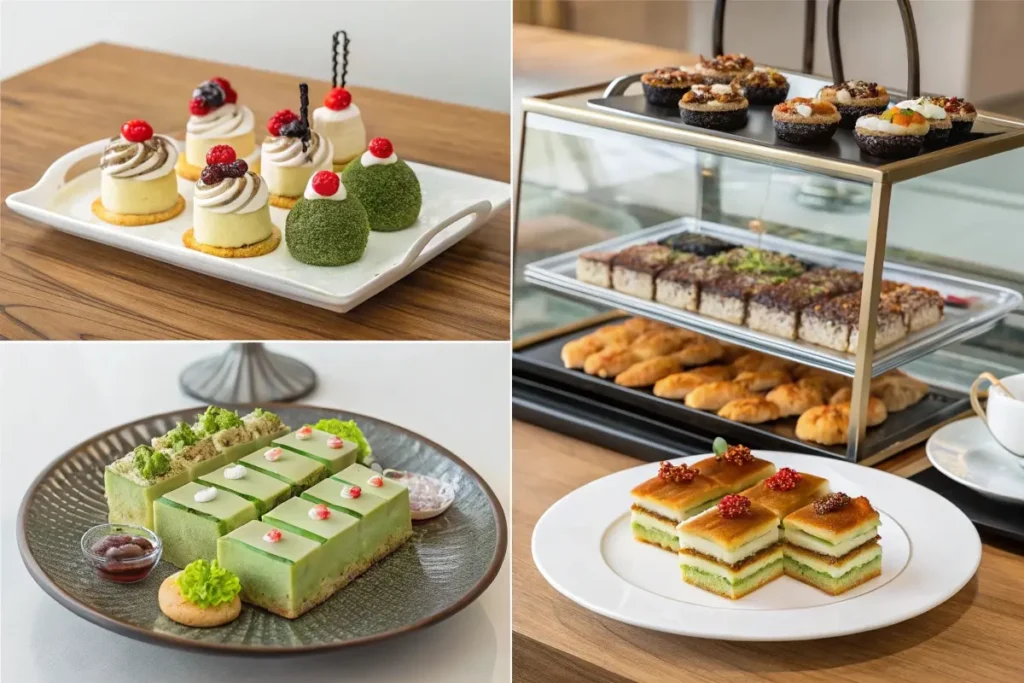
FAQs about Japanese Dessert Ideas
1. What is a popular Japanese dessert ideas?
Popular favorites vary, but mochi and matcha cakes consistently rank high. Dorayaki (pancakes with sweet bean paste) and taiyaki (fish-shaped waffles filled with anko or custard) also remain major crowd-pleasers. Modern patisseries, meanwhile, highlight airy cheesecakes or soufflé pancakes as sought-after items. For more tempting options, check out our Japanese Dessert Ideas for an array of traditional and contemporary treats that will satisfy any sweet tooth.
2. What is the most popular pastry in Japan?
Many would argue the Japanese soufflé pancake stands out for its distinct, fluffy texture. Another contender is the “double cream” cream puff, often stuffed with whipped cream and custard for a luscious bite. Regionally, you might see variations—for instance, Hokkaido’s famed dairy-based pastries.
3. What is the national sweet of Japan?
While there’s no official national dessert, wagashi—particularly the mochi and anko-based confections—could be considered the symbolic sweet. They connect deeply with historical ceremonies and the cultural practice of moderate, respectful indulgence.
4. What is a popular dessert in Tokyo?
Tokyo’s diverse population and culinary creativity produce numerous “it” desserts. Currently, matcha parfaits, taiyaki soft-serve cones, and ice cream sandwiched in fish-shaped waffles enjoy hype. Upscale patisseries also rotate limited-time offerings showcasing seasonal fruits (like strawberries or peaches).
5. Are these desserts typically very sweet?
Japanese desserts tend to be less sweet than Western counterparts. The goal is to accentuate subtle flavors—like matcha’s mild bitterness or anko’s earthy undertone—rather than smother them in sugar. This approach results in confections that feel lighter on the palate.
6. Can I make them at home easily?
Absolutely. Simple recipes like mochi, anko paste, or basic matcha cookies are beginner-friendly and require minimal specialized tools. For more intricate wagashi—shaped designs or elaborate layering—practice is key. Our Japanese Cookies can be a gateway to understanding balance and technique.
7. Where do I find the ingredients?
Asian grocers or online specialty stores often carry essentials like glutinous rice flour, matcha powder, and red bean paste. Some mainstream supermarkets stock them in international aisles. Alternatively, you can make anko from scratch using dried azuki beans and sugar.
Conclusion for Japanese Dessert Ideas
Japanese dessert ideas reflect a tapestry woven from centuries-old traditions and global influences. Whether it’s the humble wagashi (mochi, anko-based treats) beloved for tea ceremonies or the airy soufflé pancakes that took social media by storm, these desserts captivate with balanced sweetness, vibrant aesthetics, and a respect for seasonal ingredients. From the rustic countryside sweet potato pie to Tokyo’s cutting-edge pastry fusions, Japan’s dessert scene reinvents itself while honoring its core: minimal sugar, strong visuals, and a sense of delight.
In your own kitchen, tackling mochi or matcha-based pastries can seem daunting at first, but don’t be discouraged. Begin with simpler sweets like dorayaki or a basic matcha cake. Over time, you can branch into advanced artistry, such as shaping nerikiri wagashi or whisking up a silky tofu-based pudding. For consistent dessert inspiration, dive into our Japanese Desserts Recipes, and for even more creative ideas, check out our Japanese Dessert Ideas—featuring everything from classic anko confections to modern East-West hybrids.
Ready to start your Japanese dessert journey? Pick a recipe, gather your glutinous rice flour, matcha, or yuzu peel, and let the subtle, artful essence of Japanese sweets elevate your tea time or dinner party. After all, nothing encapsulates Japanese culinary spirit more than the mindful synergy of flavor, texture, and visual harmony—one sweet bite at a time. For even more inspiration, explore our Japanese Dessert Ideas to discover new and exciting treats for any occasion.
